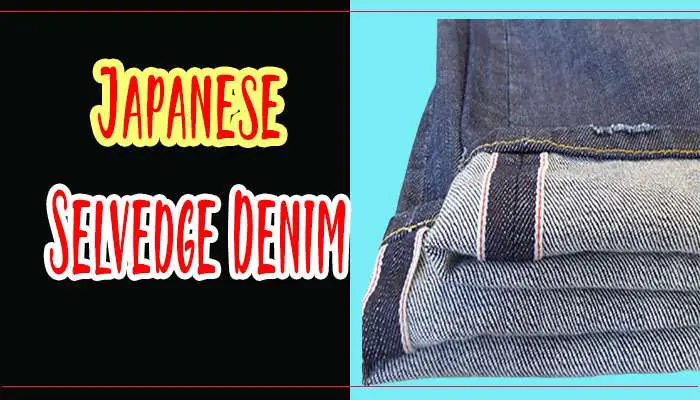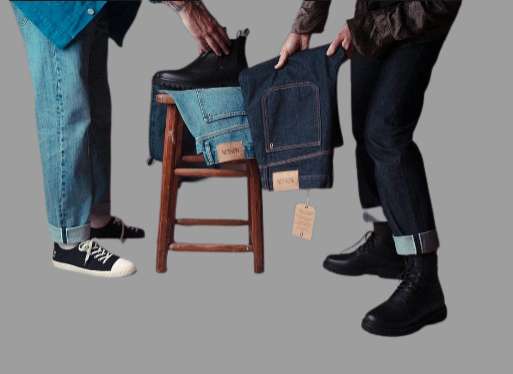What Is Japanese Selvedge Denim? Quality, History, and Style
Ah, Japanese selvedge denim – a textile symphony I’ve had the privilege of wearing and adoring for over a decade. This article is your ticket to exploring the nuanced universe of this fabric. Join me as I delve into the artistry, craftsmanship, and distinctive characteristics that set Japanese selvedge denim apart from the crowd.
What is Japanese Selvedge Denim?

Japanese selvedge denim is a type of high-quality denim fabric woven on traditional shuttle looms in Japan. The term “selvedge” (also spelled as “selvage”) refers to the self-finished edges of the fabric. These edges are tightly woven to prevent fraying and create a clean, durable finish.
Japanese selvedge denim is known for its exceptional craftsmanship and attention to detail. It is typically made from high-quality, tightly woven cotton, resulting in a dense and sturdy fabric. Traditional shuttle looms give denim a unique character, often featuring a tighter weave and a distinctive edge with a colored line or pattern.
One of the defining characteristics of Japanese selvedge denim is its deep, rich indigo color. This color comes from the dyeing process, often involving multiple dips in indigo dye to achieve the desired shade. As the denim is worn and washed over time, it develops a unique patina that reflects the wearer’s habits and lifestyle.
Also Read: Are Pacsun Jeans Good?
Origins of Japanese Selvedge Denim
The roots of Japanese selvedge denim trace back to the post-World War II era when the Japanese textile industry adopted American denim production techniques. Fast forward to today, and Japan is renowned as a denim mecca, blending traditional craftsmanship with modern innovation.
Brands like Evisu and Momotaro continue to honor this legacy, producing denim steeped in heritage and passion.

Crafting the Perfection: The Looming Artistry
Each yard of Japanese selvedge denim is an ode to patience and precision. Craftsmen operate vintage shuttle looms with unmatched skill, weaving denim inch by inch. This laborious process results in a tighter, denser fabric that’s more durable and exhibits a unique surface texture.
The naturally irregular yarns create a nuanced visual texture that gives the denim character and depth.
Distinctive Japanese Selvedge Colors
One of the captivating aspects of Japanese selvedge denim lies in its diverse color palette. Each hue tells a different story, from deep indigos reminiscent of the night sky to earthy tones inspired by nature.
Thanks to traditional dyeing techniques like rope dyeing, Japanese denim exhibits richer color saturation and an exquisite depth that intensifies with wear.
Styling Japanese Selvedge Denim

Selecting the right fit is an art in itself. Japanese selvedge denim offers a range of fits, from the classic straight cut to the modern slim fit. When choosing, consider your body type and personal style.
Also Read: What Are Skimmer Jeans?
Remember, denim’s raw nature means it will mold to your body over time, so don’t be afraid to opt for a slightly snug fit that will eventually become uniquely comfortable.
Japanese Selvedge Denim Care Guide
Caring for Japanese selvedge denim is a commitment that pays off in spades. Avoid frequent washing, which can strip away the natural indigo dye and diminish the unique fading potential. Instead, embrace spot cleaning and occasionally freeze your denim to eliminate odors.
When it’s time for a wash, turn them inside out, use a gentle cycle, and let them air dry to ensure longevity.
Japanese selvedge denim: Price vs. Value

Japanese selvedge denim may come at a higher price than regular denim due to its superior quality, craftsmanship, and unique weaving techniques. The value lies in its durability, attention to detail, distinct designs, personalized aging, and sometimes sustainable practices.
The decision on value depends on individual preferences and appreciation for premium materials and cultural significance.
Also Read: How to Measure Hips on Jeans?
FAQs About Japanese Selvedge Denim:
Can I machine wash my Japanese selvedge denim jeans?
Absolutely, but with a gentle touch! Turning them inside and using a cold, gentle cycle will minimize color loss and preserve the fabric’s integrity.
Will Japanese selvedge denim stretch over time?
Indeed, it will. While the denim might feel snug initially, it’ll gradually stretch and mold to your body for a comfortable fit that’s uniquely yours.
What makes Japanese selvedge denim special?
Japanese selvedge denim’s allure lies in its artisanal craftsmanship, distinctive texture, and unique fading patterns that tell your personal story.
Is Japanese selvedge denim worth it?
It depends on your individual needs and budget. If you are looking for a pair of durable, comfortable, and stylish jeans, then Japanese selvedge denim is a great option. However, if you are on a tight budget, other types of denim will still meet your needs.
Why is Japanese selvedge denim better?
Japanese selvedge denim is made with higher quality materials and craftsmanship than most other types of denim. It is also often dyed with natural indigo, giving it a richer, deeper color that only improves with age.
Why is Japanese denim so expensive?
Japanese denim is expensive because it is made with high-quality materials and craftsmanship. It is also made in small batches, which limits the supply and drives up the price.
Conclusion
As a devoted denim enthusiast with years of hands-on experience, Japanese selvedge denim holds a special place in my heart. Its artful creation, intricate details, and unique aging process make it a cherished wardrobe staple. Whether you’re new to denim or a seasoned aficionado, I hope this journey into Japanese selvedge denim has deepened your appreciation for its beauty and craftsmanship.






